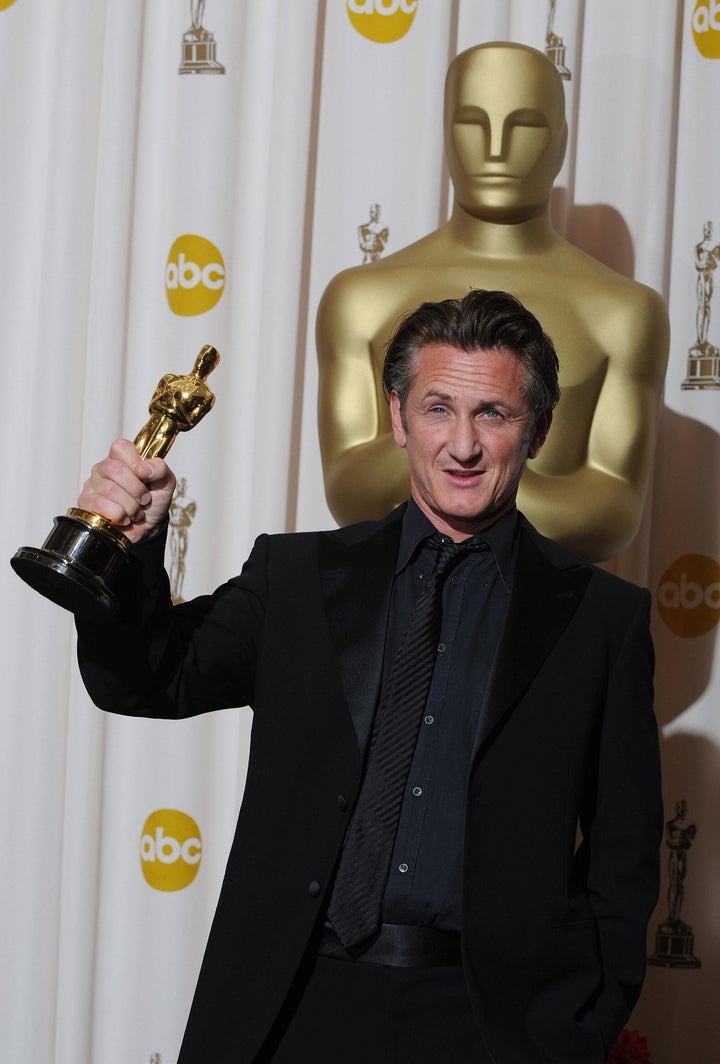
Tomorrow is your last chance to bid on clothing worn by Sean Penn in his Oscar-winning performance in Milk, being auctioned off to benefit the Harvey Milk High School in New York and Variety-The Children's Charity of Southern California. Like the nesting shirts in Ennis Del Mar's closet in the final scene of Brokeback Mountain -- the last gay-themed film to win over a sizeable mainstream audience -- Milk's suit, shirt, tie and "No on 6" pin have achieved iconic status in the GLBT community and will now benefit that community. (The auction is underway at www.clothesoffourback.org.)
Oscar-nominated costume designer Danny Glicker recreated the actual ensemble that Milk was wearing on November 7, 1978, the day he and his supporters celebrated the statewide defeat of Proposition 6, which would have initiated a witch hunt targeting gay teachers in California public schools. It's hard to believe that three decades ago the majority of California voters got it right and just three months ago they got it wrong. It's a sad fact that gay youth still need reassurances from people other than their own family, friends, teachers, clergy and public officials that "you are beautiful" and "God does love you," as Milk screenwriter Dustin Lance Black proclaimed in his emotional acceptance speech last Sunday night.
I recently sat down with Glicker -- who, like Black and director Gus van Sant, is gay -- to talk about his work on the film that's inspiring a new generation of civil rights activists. Glicker's extensive research into Milk and his milieu included hands-on visits to the GLBT Historical Society in San Francisco, which gave him generous access to Harvey Milk's original clothing, including the actual suit he was wearing when he was assassinated.
SS: So you were able to look at and handle Harvey Milk's actual clothes?
DG: Yes, they were very generous at the archives and I worked very closely with his real clothes including the suit that he was murdered in. The suit that Sean wears as Harvey when he's murdered is an exact reproduction of the suit that real Harvey was wearing. We measured everything from lapels to belt loops to the bullet holes.
SS: That must have been very intense.
DG: It was absolutely intense. It was also very precious and very humbling. I can tell you that on this movie I felt like I wasn't only a designer, I felt like I was an archivist and a journalist and I felt very protective of the story. I already felt this great responsibility to begin with. But handling the suit, wearing special white gloves -- the suit is in acid-free tissue paper on a table -- I remember touching it and touching the fabric and the shirt still covered in dried blood, and just feeling profoundly sad for the fragile humanity that it represented. At the same time I felt very grateful to be entrusted with the story. In that moment, the level of responsibility was so apparent and I felt grateful to be reminded of that--that this wasn't some fun 70s romp. It wasn't about wacky bellbottoms and kooky patterns. It was this incredibly profound story about a single person who accomplished amazing things in a very short amount of time, and then was murdered. I understood that I was there to protect the integrity of the look of the movie and to protect the integrity of the way Harvey was perceived.
SS: Sounds like you took that on as an almost sacred responsibility.
DG: When you're working with an actor of the quality of Sean Penn, you have to be absolutely dedicated to serving the story and the actor's transformation and physical experience. It cannot be an ego-driven pursuit. Costume design is about serving actors and serving directors. Of course you have to find a way to bring your ideas and experience and knowledge into it, but it is not this frivolous pursuit.
SS: There are other key characters and hundreds of extras in the film. How did you get a handle on designing the whole look of this era?
DG: Milk had two major mandates going for it regarding the look. First, it's the story of a person and a time that are very well documented, and second, I knew the movie was going to be intercut with a lot of archival footage. Not only were we documenting real people in real places but we were documenting them in a nine-year span of time, so we had these enormous binders of research in chronological order that meticulously chronicled their evolution. I have never worked on a project with more research than I had on Milk. On top of that, because so many people in the movie are associated with photography, as Harvey did own a camera store, the documentation of that time was ten-fold. That said, it was still very challenging to place it back into its proper time frame, to unlock the logic of their clothes, how they dressed, the way they wore their clothes. Anytime we were filming something that was documented, automatically I recreated it exactly as it was. If it is a documented event, Sean will always be wearing exactly what Harvey was wearing--the Levi's jackets, the suits.
SS: Do you think Milk has influenced contemporary fashion?
DG: After Milk came out there was an enormous amount of interest in the "Castro clone." Obviously it's a fabulous look from that time, but I also think that right now men are exploring in adventurous ways different forms of expressing their identity. And if you go back to the 70s, the Castro clone was a really exciting way for gay men to express their masculine identity. Now of course -- all over the glossies -- you have straight men exploring the gay aesthetic as a way of expressing their identity. You have straight guys across the country who want nothing more than to look like the boys of Abercrombie & Fitch, which is not the most traditional aspirational goal for straight guys to have. Well, maybe it's traditional if you go back to ancient Greece!

